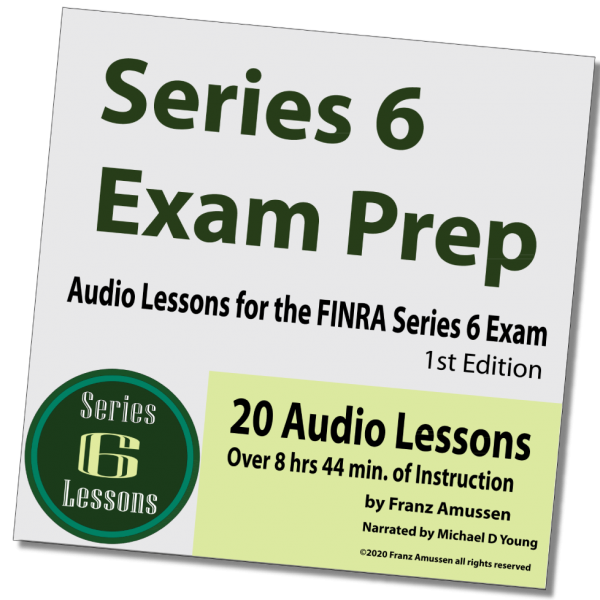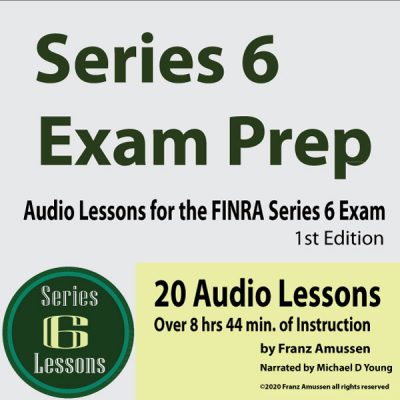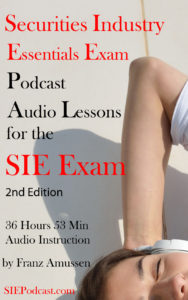Series 6 Lesson 9 Mutual Funds pt 2
Series 6 Lesson 9 Mutual Funds pt 2 Fund of Funds = a mutual fund that holds shares of many other funds
Principal Protected Funds = These funds are focused on protecting the investor’s principal. They take many steps in order to keep everything stable. These can be expensive.
Every mutual fund will have a prospectus that can help you understand their strategy, such as what kinds of investments they go after or what kind of strategies they employ. It is a good place to start when comparing mutual funds. They will often show the historical performance of the fund over time as a way to show what investors might expect in the future. They always have the disclaimer “past results are not predictive of future results”.
All funds have different expenses that are usually deducted from the proceeds. Some funds have a sales expense. This is detailed in the prospectus.
Capital appreciation happens when a mutual fund goes up in value. The mutual fund will pay out dividend on all the stock and bonds that are part of the fund. They will also give capital gains dividends to shareholders if they can. After fulfilling these requirements, the fund is then compared to where it was when it started to calculate the net asset value. If you start with $15 per share and end at $17 per share, that is $2 in capital appreciation. You also have to take any applicable taxes into consideration.
Fees can either be classified as A-shares, which charge fees up front or B-shares, which charge fees when you sell. Some funds charge a percentage fees called 12b-1 fees. C-shares do not charge an upfront fee, but they have high 12b-1 fees.
A shares: long term with over $50,000
B shares: mid or long term with a small investment
C shares: short term investor with less than $500,000 to invest
Series 6 Lesson 9 Breakpoints
The more that you invest, you can qualify for breakpoints, which is a reduction in the sales charge. The more you invest, the more you can save, based on different breakpoints.
When you want to cash in your shares, this is known as redeeming your shares. When you do this, you get the NAV per share, minus any charges if they are A-shares. This will require a signature under certain conditions:
-If the redemption is over $75,000.
-If the redemption is to someone other than the registered shareholder
-If the redemption is sent to an address other than the address of record.
Some funds will charge a redemption fee if you try to redeem them during the first year. They want you to hold onto your investment.
Investors can also set up an automatic withdrawal plan. They can get a fixed periodic payment, such as $500/month or a certain percentage every so often, quarterly, etc. You can say that you want to sell X number of shares every so often, or you can have it withdrawn over a specific amount of time, two years, etc.
A mutual fund has a Board of Directors. They establish investment policy, they appoint other people oversight positions, establish policies about capital gains and dividends, and review/approve 12b-1 plans. They oversee operations, but do not make the investment decisions themselves, just like any normal company.
The investment adviser/portfolio manager is appointed by the BOD. He or she is the one who actually manages the fund’s investments according to the fund’s stated policies. They are paid a percentage of the fund’s net assets.
The custodian is a bank that holds all of the assets of the mutual fund, such as cash and securities. They are the container for all of the fund’s securities.
The transfer agent is the party that issues shares of the mutual fund to buyers and redeems shares from sellers. They distribute dividends to investors.
Mutual fund shareholders are like normal company shareholders and so they get to vote about matters of fund business, such as when there are changes in investment strategies, changes in fees, elections of board members, changing from an open-end to close-end fund, etc.
Management Companies
Open-end Funds vs. Closed-end Funds
Traditional mutual funds are open-end funds. There are not a fixed number of shares.
Closed-end Funds are an IPO and they have a fixed number of shares. You have to trade it like a normal share of stock. You will get whatever a buyer is willing to pay for the share. You have to buy a round number of shares, no partial shares for closed-end funds.
ETF Fund = exchange-traded fund. This is a fund that trades on an exchange and the investors want it to do well on a particular exchange, such as the S & P 500.
We also offer lessons for:
The Series 7 Exam
https://gumroad.com/l/ILYu
The Series 22 Exam
https://series6lessons.com/series-22-exam/
The Series 63 Exam
https://series6lessons.com/series-63-exam-lessons/
The Life Health Insurance Exam
https://series6lessons.com/insurance-lessons/
The SIE Exam (Securities Industries Essentials Exam)
https://series6lessons.com/finra-sie/
Click on any of them to find out more
Podcast: Play in new window | Download (Duration: 10:52 — 4.5MB)
Subscribe: Apple Podcasts | RSS | Subscribe to Podcast




